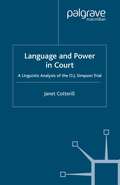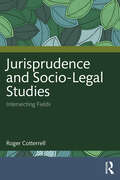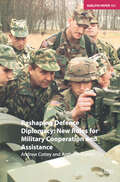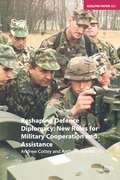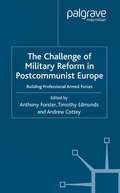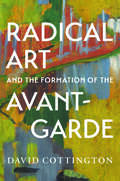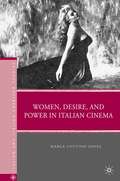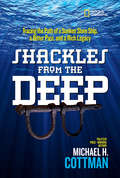- Table View
- List View
The Imperial Capitals of China: An Inside View of the Celestial Empire
by Arthur CotterellAs China- the oldest continuous civilisation in existence- stands to become the most influential, with its economy expected to exceed that of the United States by 2020, Arthur Cotterell provides a panoramic sweep of an empire that lasted over two millennia through the imperial capitals that were the very foundations of each dynasty. Using original Chinese sources and eyewitness accounts he provides an inside view of the rich array of characters, political and ideological tensions, and technological genius that defined the imperial capitals of China, as each in turn is revealed, explored and celebrated.From the cosmological foundations of the first capital to the politics of empire and cataclysmic civil wars, this absorbing new book offers a level of insight indispensible for a true understanding of China today.
The Near East: A Cultural History
by Arthur CotterellThis ambitious and wide-ranging popular history is the first narrative account of the entire Near East (Turkey, Iraq, Syria, Lebanon, Jordan, Israel, Saudi Arabia and the Gulf States), from the genesis of civilization in the fourth millennium BCE until modern times. It provides an historical outline of the civilizations and cultures that dominated the region, one that has had an immense impact on the development of humankind, ever since the ancient Sumerians invented urban living and writing around 3200 BCE. Later, the Babylonians and the Assyrians built upon the Sumerian legacy. They were the world's earliest great powers, whose actions in the cradle of monotheism influenced Judaism and, eventually, Christianity and Islam. The Near East discusses the long eras of Arab, Persian and Ottoman rule, and the destabilizing intervention of Western colonial powers. Cotterell's book is a timely reminder of how historical events have shaped the outlooks of various peoples, just as political turbulence in the Near East is challenging both neighboring countries and the wider world.
The Near East: A Cultural History
by Arthur CotterellThis ambitious and wide-ranging popular history is the first narrative account of the entire Near East (Turkey, Iraq, Syria, Lebanon, Jordan, Israel, Saudi Arabia and the Gulf States), from the genesis of civilization in the fourth millennium BCE until modern times. It provides an historical outline of the civilizations and cultures that dominated the region, one that has had an immense impact on the development of humankind, ever since the ancient Sumerians invented urban living and writing around 3200 BCE. Later, the Babylonians and the Assyrians built upon the Sumerian legacy. They were the world's earliest great powers, whose actions in the cradle of monotheism influenced Judaism and, eventually, Christianity and Islam. The Near East discusses the long eras of Arab, Persian and Ottoman rule, and the destabilizing intervention of Western colonial powers. Cotterell's book is a timely reminder of how historical events have shaped the outlooks of various peoples, just as political turbulence in the Near East is challenging both neighboring countries and the wider world.
The Pimlico Dictionary Of Classical Civilizations
by Arthur CotterellAn original and unique work of reference which breaks new ground by treating for the first time the classical era of the Old World as a whole. Never before have the key peoples and events of Greece, Rome, Persia, India, and China been encompassed in a single volume, despite the fact their civilizations had much in common and laid the foundations of present-day Europe and Asia. Arthur Cotterell asserts that for too long Greece and Rome have been regarded as the classical world and its study isolated from even the major powers that confronted the Greeks and Romans in Iran and India. Today we are more aware of the complex interrelations that once existed between the Greeks and the Persians, the Macedonians and the Indians, the Romans and both the Persians and the Sasanians. The persistent isolation of China, on the other hand, cut off by mountains and deserts from India, makes the classical experience there so useful for comparison and contrast. The virtual absence of slavery in China is but one of its startling features.Comprehensive, wide-ranging and lavishly illustrated, The Pimlico Dictionary of Classical Civilizations provides a fascinating overview and a detailed analyis of the formative period of the world, making it indispensible for both students and the general reader.
The Serge Trotsky Papers: Correspondence and Other Writings Between Victor Serge and Leon Trotsky
by David CotterillLeon Trotsky and Victor Serge represent the great and tragic oppositional figures to Stalin's dictatorial grip on the Soviet Union in the late 1920s and 1930s. Written during this period, the letters exchanged between these two friends, published here in translation for the first time together with other material from both the Trotsky Archive at Harvard and the Serge Archive in Mexico, present a unique first-hand account of the alternatives and arguments of the Trotskyist opposition in exile. The correspondence chronicles Trotsky’s attempts to found a new Fourth International and casts new light on the trajectory of the Russian revolution from Lenin to Stalin and the long term effects of Stalinism for the revolutionary movements in the West. A remarkable insight into the lives of two prominent thinkers of the twentieth century, these letters also help us to understand an important relationship during a critical period in European politics. Each section is prefaced by a clear introduction that contextualises and clarifyies the documents.
The Serge Trotsky Papers: Correspondence and Other Writings Between Victor Serge and Leon Trotsky
by David CotterillLeon Trotsky and Victor Serge represent the great and tragic oppositional figures to Stalin's dictatorial grip on the Soviet Union in the late 1920s and 1930s. Written during this period, the letters exchanged between these two friends, published here in translation for the first time together with other material from both the Trotsky Archive at Harvard and the Serge Archive in Mexico, present a unique first-hand account of the alternatives and arguments of the Trotskyist opposition in exile. The correspondence chronicles Trotsky’s attempts to found a new Fourth International and casts new light on the trajectory of the Russian revolution from Lenin to Stalin and the long term effects of Stalinism for the revolutionary movements in the West. A remarkable insight into the lives of two prominent thinkers of the twentieth century, these letters also help us to understand an important relationship during a critical period in European politics. Each section is prefaced by a clear introduction that contextualises and clarifyies the documents.
Language and Power in Court: A Linguistic Analysis of the O.J. Simpson Trial
by J. CotterillSociolinguists and lawyers will find insight and relevance in this account of the language of the courtroom, as exemplified in the criminal trial of O.J. Simpson. The trial is examined as the site of linguistic power and persuasion, focusing on the role of language in (re)presenting and (re)constructing the crime. In addition to the trial transcripts, the book draws on Simpson's post-arrest interview, media reports and post-trial interviews with jurors. The result is a unique multi-dimensional insight into the 'Trial of the Century' from a linguistic and discursive perspective.
Saint Perpetua across the Middle Ages: Mother, Gladiator, Saint (The New Middle Ages)
by Margaret Cotter-LynchThis study traces the genealogy of Saint Perpetua’s story with a straightforward yet previously overlooked question at its center: How was Perpetua remembered and to what uses was that memory put? One of the most popular and venerated saints from 200 CE to the thirteenth century, the story of Saint Perpetua was retold in dramatically different forms across the European Middle Ages. Her story begins in the arena at Carthage: a 22-year-old nursing mother named Vibia Perpetua was executed for being a Christian, leaving behind a self-authored account of her time in prison leading up to her martyrdom. By turns loving mother, militant gladiator, empathic young woman, or unattainable ideal, Saint Perpetua’s story ultimately helps to trace the circulation of texts and the transformations of ideals of Christian womanhood between the third and thirteenth centuries.
Saint Perpetua across the Middle Ages: Mother, Gladiator, Saint (The New Middle Ages)
by Margaret Cotter-LynchThis study traces the genealogy of Saint Perpetua’s story with a straightforward yet previously overlooked question at its center: How was Perpetua remembered and to what uses was that memory put? One of the most popular and venerated saints from 200 CE to the thirteenth century, the story of Saint Perpetua was retold in dramatically different forms across the European Middle Ages. Her story begins in the arena at Carthage: a 22-year-old nursing mother named Vibia Perpetua was executed for being a Christian, leaving behind a self-authored account of her time in prison leading up to her martyrdom. By turns loving mother, militant gladiator, empathic young woman, or unattainable ideal, Saint Perpetua’s story ultimately helps to trace the circulation of texts and the transformations of ideals of Christian womanhood between the third and thirteenth centuries.
Jurisprudence and Socio-Legal Studies: Intersecting Fields
by Roger CotterrellThis book presents a set of related studies aimed at showing key points of intersection and common interest between jurisprudence and socio-legal studies, which are otherwise typically considered distinct fields. It reflects and draws on the author’s work in these areas over more than four decades.The first half of the book explores theoretical issues surrounding the enterprise of socio-legal research, its current scope, and its historical traditions. Some chapters directly compare juristic theory and socio-legal inquiry. Chapters in Part II profile a selection of European jurists whose work offers important insights for socio-legal inquiry. Other chapters frame these studies, explore the history of interactions between jurisprudence and socio-legal research, and show points of convergence between these fields that are increasingly important today. A main aim of the book is to show the current urgency of linking and broadening juristic and social scientific interests in law.Internationally oriented, the book will be of interest to students and researchers in the areas of jurisprudence, legal philosophy, sociology of law, socio-legal studies, and comparative law. It is suitable as supplementary reading for courses in any of these subjects.
Jurisprudence and Socio-Legal Studies: Intersecting Fields
by Roger CotterrellThis book presents a set of related studies aimed at showing key points of intersection and common interest between jurisprudence and socio-legal studies, which are otherwise typically considered distinct fields. It reflects and draws on the author’s work in these areas over more than four decades.The first half of the book explores theoretical issues surrounding the enterprise of socio-legal research, its current scope, and its historical traditions. Some chapters directly compare juristic theory and socio-legal inquiry. Chapters in Part II profile a selection of European jurists whose work offers important insights for socio-legal inquiry. Other chapters frame these studies, explore the history of interactions between jurisprudence and socio-legal research, and show points of convergence between these fields that are increasingly important today. A main aim of the book is to show the current urgency of linking and broadening juristic and social scientific interests in law.Internationally oriented, the book will be of interest to students and researchers in the areas of jurisprudence, legal philosophy, sociology of law, socio-legal studies, and comparative law. It is suitable as supplementary reading for courses in any of these subjects.
Living Law: Studies in Legal and Social Theory
by Roger CotterrellLiving Law presents a comprehensive overview of relationships between legal and social theory, and of current approaches to the sociological study of legal ideas. It explores the nature of legal theory and sociolegal studies today as teaching and research fields, and the work of many of the major sociolegal theorists. In addition, it sets out the author's distinctive approach to sociological analysis of law, applying this in a range of studies in specific legal fields, such as the law of contract, property and trusts, constitutional analysis, and comparative law.
Living Law: Studies in Legal and Social Theory (Collected Essays In Law Ser.)
by Roger CotterrellLiving Law presents a comprehensive overview of relationships between legal and social theory, and of current approaches to the sociological study of legal ideas. It explores the nature of legal theory and sociolegal studies today as teaching and research fields, and the work of many of the major sociolegal theorists. In addition, it sets out the author's distinctive approach to sociological analysis of law, applying this in a range of studies in specific legal fields, such as the law of contract, property and trusts, constitutional analysis, and comparative law.
Democratic Control of the Military in Postcommunist Europe: Guarding the Guards (One Europe or Several?)
by A. Cottey T. Edmunds Anthony ForsterThis major comparative study examines the challenges that the countries of postcommunist Central and Eastern Europe have faced in securing democratic control of their armed forces and establishing civilian control of defence policy. This book explores how the interaction of the common challenges of postcommunism and the diverse circumstances of individual countries shape civil-military relations in this changing region. Detailed country case studies, written by leading experts, compare the experiences of the Central European states (such as Poland and Romania), the Baltic republics, the former Yugoslavia republics, Russia and Ukraine.
Reshaping Defence Diplomacy: New Roles for Military Cooperation and Assistance (Adelphi series)
by Andrew CotteyAnalyses changing patterns of international military cooperation and assistance and shows that Western defence diplomacy is increasingly being directed towards new goals. The new defence diplomacy runs alongside the old and there are tensions between the two, in particular between the new goal of promoting democracy and the old imperative of supporting authoritarian allies.
Reshaping Defence Diplomacy: New Roles for Military Cooperation and Assistance (Adelphi series)
by Andrew CotteyAnalyses changing patterns of international military cooperation and assistance and shows that Western defence diplomacy is increasingly being directed towards new goals. The new defence diplomacy runs alongside the old and there are tensions between the two, in particular between the new goal of promoting democracy and the old imperative of supporting authoritarian allies.
Subregional Cooperation in the New Europe: Building Security, Prosperity and Solidarity from the Barents to the Black Sea
by Andrew CotteyBased on a major international research project undertaken by The Institute for East West Studies, this book provides the first comprehensive analysis of an important, but little explored, feature of post-Cold War Europe: the emergence of subregional cooperation in areas such as the Barents, the Baltic Sea, Central Europe and the Black Sea. It analyses the role of subregional cooperation in the new Europe, provides detailed case studies of the new subregional groups and examines their relations with NATO and the European Union.
The Challenge of Military Reform in Postcommunist Europe: Building Professional Armed Forces (One Europe or Several?)
by Andrew Cottey A. Forster T. EdmundsThis major comparative study examines the challenges faced by countries of postcommunist Europe in reforming and professionalizing their armed forces. It explores how the interaction of the common challenges of postcommunism and the diverse circumstances of individual countries are shaping professionalization processes in this changing region. The detailed country case studies in this volume, written by leading experts to a common analytical framework, compare the experiences of Poland, the Czech Republic, Slovakia, Hungary, Latvia, Lithuania, Romania, Bulgaria, Slovenia, Croatia, FRY, Russia and Ukraine.
Fear Eats the Soul (BFI Film Classics)
by Laura CottinghamIn Rainer Werner Fassbinder's Fear Eats the Soul (Angst Essen Seele Auf, 1974) Emma (Brigitte Mira), a working-class widow and former member of the Nazi party, marries Ali (El Hedi ben Salem), a much younger Moroccan migrant worker. Set in Munich during the 1970s, the film melds the conventions of melodrama with a radical sensibility to present a portrait of racism and everyday hypocrisy in post-war Germany. It is a film about the way conventional society detests anything and anybody unfamiliar - but also a film about the hopes and limits of love. Intricately directed, beautifully performed, and designed to show Munich life in all its shabby kitschiness, Fear Eats the Soul may be Fassbinder's finest film.Laura Cottingham celebrates Fassbinder's achievement, placing Fear Eats the Soul in relation to his extraordinarily prolific career in theatre, film and television. Her analysis pulls back the thin curtain that separated his work from his tumultuous life. She also explores the director's debt to the lush Hollywood melodramas made by fellow German Douglas Sirk, especially All That Heaven Allows (1955). In a detailed scene-by-scene analysis, Cottingham shows how Fassbinder managed to combine beauty and tenderness with fierce political critique.
Fear Eats the Soul (BFI Film Classics)
by Laura CottinghamIn Rainer Werner Fassbinder's Fear Eats the Soul (Angst Essen Seele Auf, 1974) Emma (Brigitte Mira), a working-class widow and former member of the Nazi party, marries Ali (El Hedi ben Salem), a much younger Moroccan migrant worker. Set in Munich during the 1970s, the film melds the conventions of melodrama with a radical sensibility to present a portrait of racism and everyday hypocrisy in post-war Germany. It is a film about the way conventional society detests anything and anybody unfamiliar - but also a film about the hopes and limits of love. Intricately directed, beautifully performed, and designed to show Munich life in all its shabby kitschiness, Fear Eats the Soul may be Fassbinder's finest film.Laura Cottingham celebrates Fassbinder's achievement, placing Fear Eats the Soul in relation to his extraordinarily prolific career in theatre, film and television. Her analysis pulls back the thin curtain that separated his work from his tumultuous life. She also explores the director's debt to the lush Hollywood melodramas made by fellow German Douglas Sirk, especially All That Heaven Allows (1955). In a detailed scene-by-scene analysis, Cottingham shows how Fassbinder managed to combine beauty and tenderness with fierce political critique.
Seeing Through the Seventies: Essays on Feminism and Art (Critical Voices In Art, Theory, Culture Ser.)
by Laura CottinghamIn recent years, Laura Cottingham has emerged as one of the most visible feminist critics of the so-called post-feminist generation. Following a social-political approach to art history and criticism that accepts visual culture as part of a larger social reality, Cottingham's writings investigate central tensions currently operative in the production, distribution and evaluation of art, especially those related to cultural production by and about women.Seeing Through the Seventies: Essays on Feminism and Art gathers together Cottingham's key essays from the 1990's. These include an appraisal of Lucy R. Lippard, the most influential feminist art critic of the1970's; a critique of the masculinist bias implicit to modernism and explicitly recuperated by commercially successful artists during the 1980s; an exhaustive analysis of the curatorial failures operative in the "Bad Girls" museum exhibitions of the early 1990s; surveys of feminist-influenced art practices during the women's liberationist period; speculations on the current possibilities and obstacles that attend efforts to recover lesbian cultural history; and an examination of the life, work and obscuration of the early twentieth-century French photographer Claude Cahun.
Seeing Through the Seventies: Essays on Feminism and Art
by Laura CottinghamIn recent years, Laura Cottingham has emerged as one of the most visible feminist critics of the so-called post-feminist generation. Following a social-political approach to art history and criticism that accepts visual culture as part of a larger social reality, Cottingham's writings investigate central tensions currently operative in the production, distribution and evaluation of art, especially those related to cultural production by and about women.Seeing Through the Seventies: Essays on Feminism and Art gathers together Cottingham's key essays from the 1990's. These include an appraisal of Lucy R. Lippard, the most influential feminist art critic of the1970's; a critique of the masculinist bias implicit to modernism and explicitly recuperated by commercially successful artists during the 1980s; an exhaustive analysis of the curatorial failures operative in the "Bad Girls" museum exhibitions of the early 1990s; surveys of feminist-influenced art practices during the women's liberationist period; speculations on the current possibilities and obstacles that attend efforts to recover lesbian cultural history; and an examination of the life, work and obscuration of the early twentieth-century French photographer Claude Cahun.
Radical Art and the Formation of the Avant-Garde
by David CottingtonAn authoritative re-definition of the social, cultural and visual history of the emergence of the “avant-garde” in Paris and London Over the past fifty years, the term "avant-garde" has come to shape discussions of European culture and modernity, ubiquitously taken for granted but rarely defined. This ground-breaking book develops an original and searching methodology that fundamentally reconfigures the social, cultural, and visual context of the emergence of the artistic avant-garde in Paris and London before 1915, bringing the material history of its formation into clearer and more detailed focus than ever before. Drawing on a wealth of disciplinary evidence, from socio-economics to histories of sexuality, bohemia, consumerism, politics, and popular culture, David Cottington explores the different models of cultural collectivity in, and presumed hierarchies between, these two focal cities, while identifying points of ideological influence and difference between them. He reveals the avant-garde to be at once complicit with, resistant to, and a product of the modernizing forces of professionalization, challenging the conventional wisdom on this moment of cultural formation and offering the means to reset the terms of avant-garde studies.
Women, Desire, and Power in Italian Cinema (Italian and Italian American Studies)
by M. Cottino-JonesWomen, Desire, and Power in Italian Cinema offers, for the first time in Italian Cinema criticism, a contextual study of the representation of women in twentieth-century Italian films. Marga Cottino-Jones argues that the ways women are depicted on screen reflects a subconscious "sexual conservatism" typical of an Italian society rooted within a patriarchal ideology. The book then follows the slow but constant process of social awareness in the Italian society through women in film, especially after the 1950s. Comprehensive in scope, this book analyzes the films of internationally known male and female directors, such as Antonioni, Fellini, Rossellini, Visconti, Bertolucci, Benigni, Cavani, Wertmuller, Comencini, and Archibugi. Special consideration is given to the actresses and actors that have become the icons of Italian femininity and masculinity, such as Sofia Loren, Gina Lollobrigida, Silvana Mangano, Gian Carlo Giannini, Marcello Mastroianni, and Alberto Sordi.
Shackles From the Deep: Tracing The Path Of A Sunken Slave Ship, A Bitter Past, And A Rich Legacy (History (US))
by Michael Cottman National Geographic KidsA pile of lime-encrusted shackles discovered on the seafloor in the remains of a ship called the Henrietta Marie, lands Michael Cottman, a Washington, D.C.-based journalist and avid scuba diver, in the middle of an amazing journey that stretches across three continents, from foundries and tombs in England, to slave ports on the shores of West Africa, to present-day Caribbean plantations. This is more than just the story of one ship – it's the untold story of millions of people taken as captives to the New World. Told from the author's perspective, this book introduces young readers to the wonders of diving, detective work, and discovery, while shedding light on the history of slavery. From the Hardcover edition.




